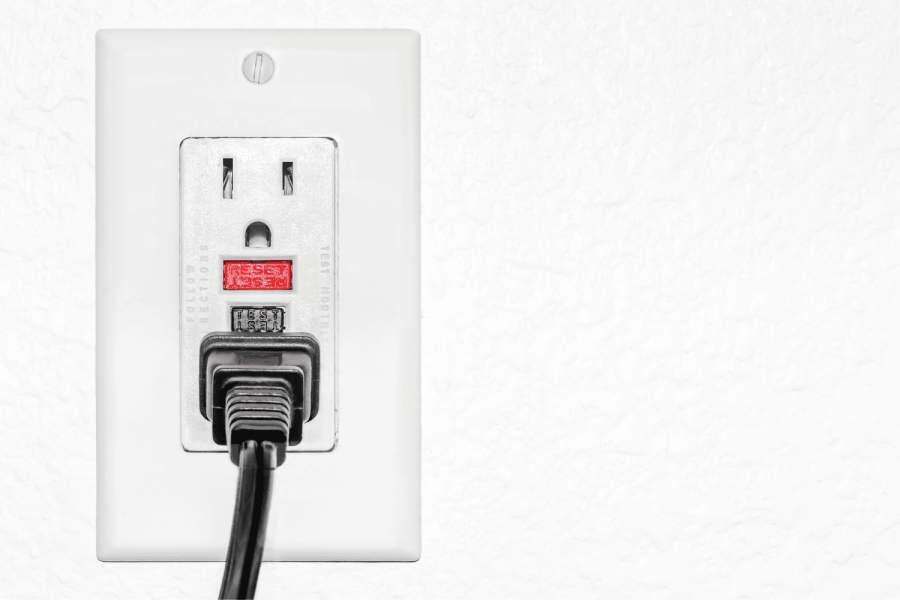There are several hurdles that can stop you from buying a bidet, and dealing with electricity and wiring is likely the biggest.
As you’ve landed on this page, I’m assuming you don’t want to take the easy route and opt for a non-electric bidet. After all, nothing compares to having a luxury heated seat and warm air dryer.
A cost-effective and simple alternative to having an electrician wire a new outlet is to use an extension cord. In this article, I cover the most frequently asked questions about bidet extension cords, including:
- What’s the best extension cord for use with a bidet?
- If it’s safe to use an extension cord with a bidet
- Exactly how to install your bidet extension so it’s safe and concealed
- What bidet manufacturers say about using extension cords with their bidets
Ready? Let’s jump right in.
3FT Extension

This 3ft extension cord comes in both white and black and is rated for use up to 1875W.
6FT Extension

The same extension in a 6ft length. Suitable for the vast majority of bidets and comes in both black and white.
What’s the best bidet extension cord?
The best bidet extension cord is the FIRMERST 1875W 15A Flat Plug Low Profile Extension Cord. The extension cord comes in a variety of lengths and is UL and CUL listed for maximum safety. The extension cord also features a unique flat-plug design that doesn’t block the bottom AC outlet.
You need an extension lead that:
- Has a 3 wired extension cord
- Rated to handle at least (but preferably more) than your bidets max power consumption. 15 amps (1875 watts) should be safe for most bidets, but this is easy to check.
- Has a heavy-duty cord.
- Is the right length for your needs (not too long or short).

I recommend the FIRMERST brand. They have a range of different 15 amp extensions cords. You’ll be able to find a suitable length and you can pick from black or white.
The extension cords have a super convenient ‘flat plug’. The plug can fit in really tight spaces and won’t block other ports in the same receptacle.
Most people will likely need either a 3 foot or 6 foot cord. FIRMERST offers both these lengths, as well as 10, 15 or 25 foot.
The eagle eyed amongst you will notice that Kohler recommends a 12 gauge lead and FIRMIRST leads are 14 gauge.
Gauge (also referred to as AWG, or American Wire Gauge) refers to the thickness of the wires inside the extension. 12 gauge wire is slightly thicker than 14. 14 gauge is perfectly acceptable for use with a bidet, but Kohler is choosing to be extra cautious.
The reason I’m recommending a 14 gauge lead is simply that there’s a lot more choice. 12 gauge leads are much harder to find, tend to be very long, and are commonly found in obnoxiously bright colors.
I don’t know about you, but I don’t want my bathroom to look like a construction site!

There is hope though. Iron Forge Cables is a great brand that sells short 12 gauge, 15 amp extension leads. They have a 6ft and a 10ft lead in black. They also sell short-ish outdoor-rated cords!
Sadly I haven’t had any luck in finding 12 gauge, white extension leads.
How do I know how much power my bidet needs?
The main thing is to make sure the cord can carry the amount of power you need it to.
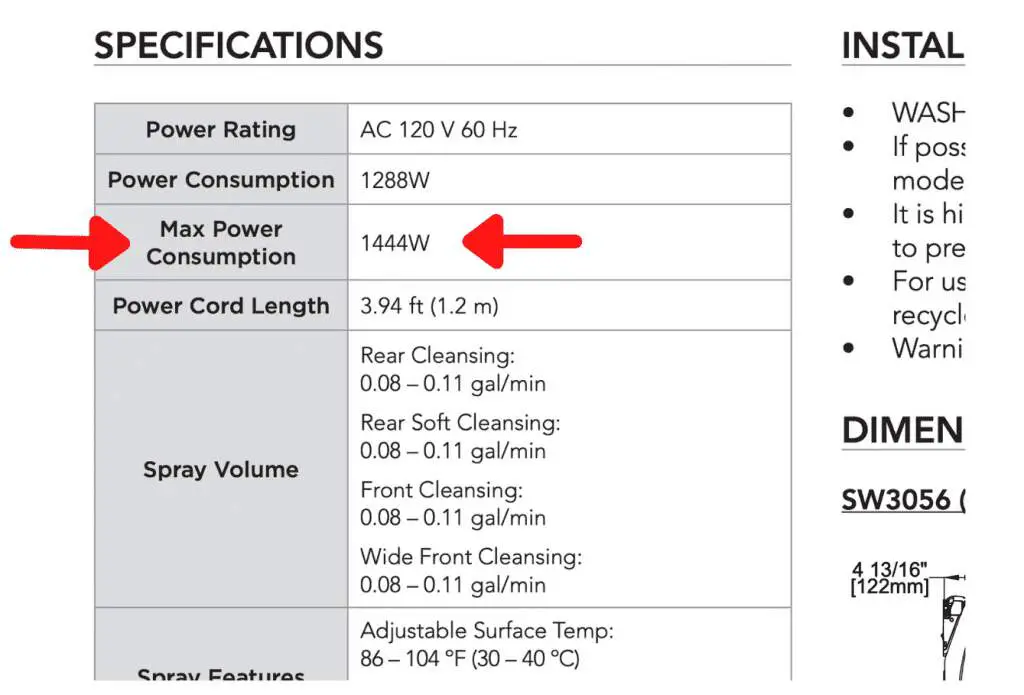
To check how much power you bidet uses, look in your bidet’s owners manual. On the specifications page you’ll find it’s ‘max power consumption’.
This is the maximum amount of power your bidet will draw from the plug, and your extension cord needs to be able to carry that amount of power.
It may be in Watts or Amps.
I suggest 15 Amps (1800 Watts) as a minimum because most tankless bidets require around 1400-1500 Watts. I always advise leaving a bit of leeway.
Your extension cord may well outlive your bidet, so you want to make sure it will be able to handle your next bidet purchase. And as technology advances, the power your future bidet requires may increase.
Maybe one day we’ll finally get a decent bidet dryer!
Here are a few examples of popular bidets and their maximum power consumption:
| Bidet | Water heating method | Max power consumption (Watts / Amps) |
| Toto S550e | Tankless | 1444W / 12A |
| Toto C200 | Tank | 406W / 3.4A |
| Brondell Swash 1400 | Tankless | 1200W / 10A |
| Bio Bidet BB-2000 | Tankless | 1400W / 11.7A |
| Smart Bidet 1000 | Tank | 660W / 5.5A |
As you can see, tankless bidets have a higher max power consumption than bidets with a hot water tank.
If you use an extension cord that can’t handle the required power, you’re at high risk of the cord overheating. This can lead to a fire.
What else do I need to consider?
Another thing you need to consider is the length you need.
It’s bad practice to daisy chain extension cords together, so always get one that will cover the entire distance you need. But don’t go overboard because you want to avoid ending up with loads of extra wire.
Measure out where you plan to route the extension cord and then get the closet lead you can to fit that length.
You might have heard that as an extension cord gets longer, the current-carrying capacity is reduced. But this doesn’t have much effect until the cord gets over 50 feet.
I doubt many of you will need a 50ft cord, and if you do, I’d get on the phone to an electrician and ask them to install an outlet.
Do I need an outdoor extension cord?
Some people suggest it’s safest to get a cord that’s suitable for outdoor use (like this one from Iron Forge cables). Outdoor extension cords are made to withstand changing weather conditions, and so will be better able to handle the heat and moisture in your bathroom.
However, this isn’t a requirement.
Bidet manufacturers agree (see bidet manufacturer quotes below). I couldn’t find a single brand that recommends using an outdoor extension cord.
Why? Well, it’s already a requirement to be using a GFCI outlet (more on this below). And of course, the cable won’t be used outdoors.
Most outdoor cords are extremely long and have a garish color. A properly placed indoor cord will perform just as well as an outdoor cable.
Can I plug multiple devices into the bidet extension cord?
I wouldn’t recommend a multi-port extension cord. The more things you plug into the extension lead, the more stress you put it under and the more likely it is to overheat.
If several things are pulling power at once, this can easily overwhelm an extension cord. Stick to just the bidet.
Is it safe to use an extension cord with a bidet?
It’s perfectly safe to use an extension cord with a bidet.
You need a 3-wired extension cord that’s rated to handle at least 15 amps (1800 watts) and you need to plug it into a GFCI protected outlet. Keep the extension cord off the floor and only use one, don’t use multiple.
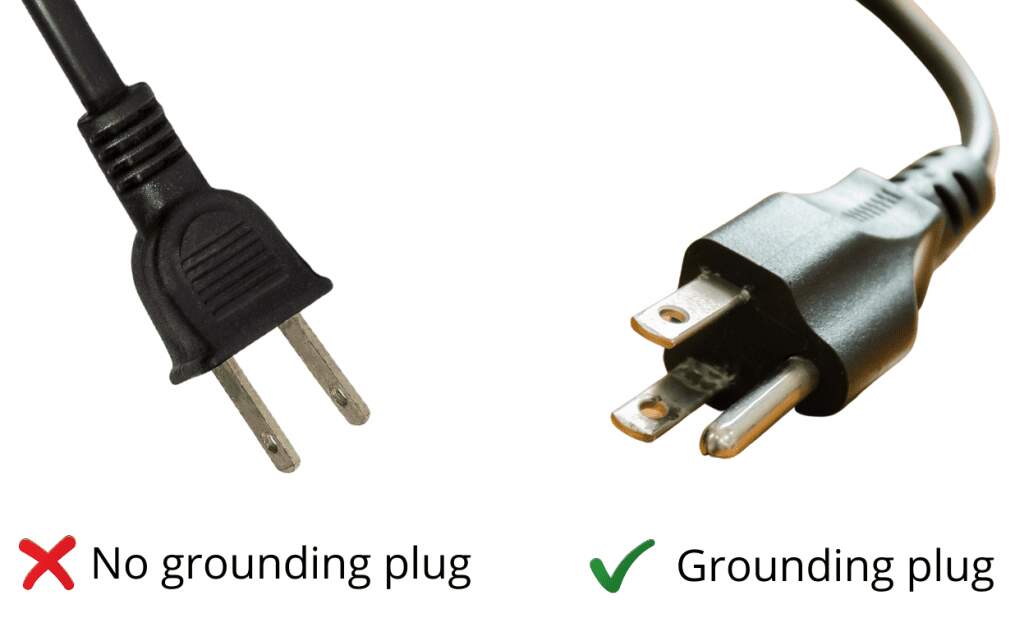
Of course, there are risks when you install an electrical appliance in your bathroom, and you’ll slightly increase this risk by adding an extension cord.
But the risk is so small it’s not considered significant, even with the addition of an extension cord.
If you follow the necessary precautions, there’s no reason why your bidet won’t work perfectly with an extension cord. I discuss these precautions below.
What do bidet manufacturers say?
Most bidet manufacturers accept that extension lead usage is unavoidable and that it’s unrealistic to expect nobody to use one.
While they don’t advocate the use of them, they do provide instructions on how you can do so safely.
Here’s a roundup of some popular brands and the advice they give about using extension cords:
- Toto: “If it is necessary to use an extension cord, use only a three-wire extension cord that has a three-blade grounding plug, and a three-slot receptacle outlet that will accept the plug on the product”
- Brondell: “If it is necessary to use an extension cord, only use those rated for a minimum of 15 amps with a three-wire extension cord with a three-blade grounding plug”
- Smart bidet: “The SmartBidet extension cord is 3’10”. If the cord does not reach, we recommend that you use an extension cord aligned against the wall”
- Bio bidet: “Yes, you may use an extension cord. We don’t recommend prolonged use, but for a few months will be fine. Needs to be at least 15A. 120V and 60Hz”
- Kohler: “A single extension cord may be used provided the cord “Type” begins with “SJ”, 12 gauge, grounded (12/3), no longer than 25 feet, and plugged into a GFCI outlet. Promptly replace any extension cord that exhibits any sign of damage” (note, for some of their bidets they state ‘do not use an extension cord’).
You’ll see a few of the brands are cautious with recommending extension cables for long-term use. This is because there are (very small) risks associated with it, not because you can’t do it.
The brands can’t guarantee that everyone will install their extension cord correctly.
And they’d rather play on the safe side by saying don’t use one than risk someone getting hurt.
What are the risks associated with using an extension cord in your bathroom?
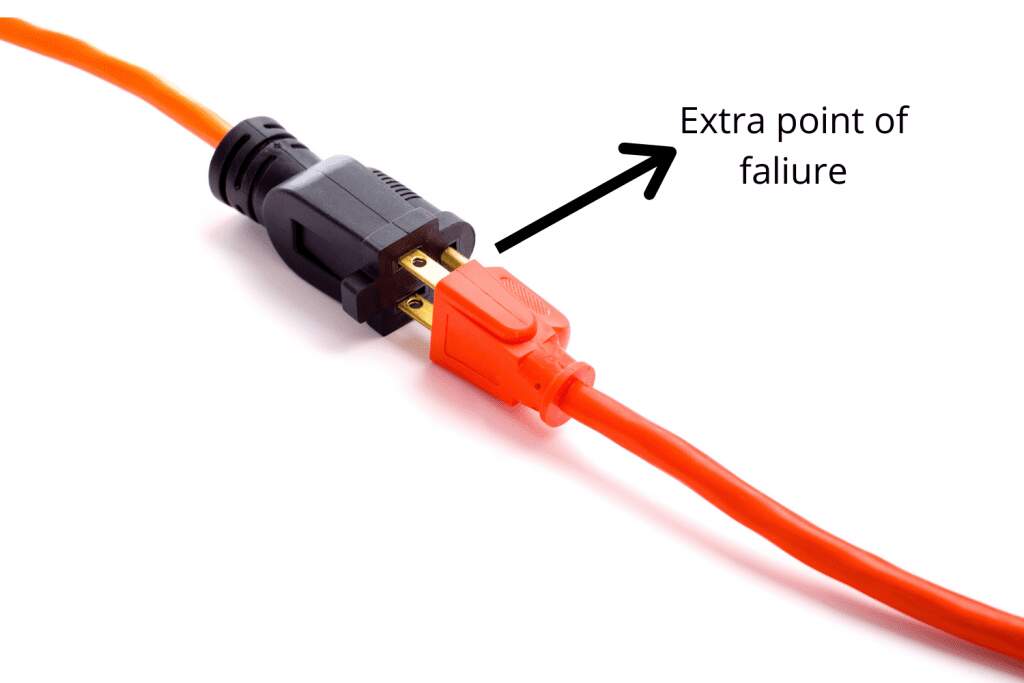
Let me preface this by saying any risks are extremely small and not something you need to worry about.
The perceived risk comes from the fact that you’re adding in an extra point of failure where the extension cord meets the bidet cord.
It’s another point where water could infiltrate your system and therefore increases the risk of an electric shock (which is so small it’s almost non-existent). Things like trailing the extension cord along the floor, or leaving it somewhere where someone could trip over it will further increase the chance of an electric shock.
And let’s not forget, this is exactly why GFCI outlets are required.
Also, if you chose an extension cord that can’t handle the power your bidet uses, then you’re creating a fire risk.
Both these issues are easily mitigated by choosing a suitable extension cord, and installing it correctly.
What are the signs of a damaged extension cord?
If you ever notice your extension cord becoming warm to the touch or becoming stiff, these are bad signs and you should stop using it.
Also, if you notice any nicks or cuts in the extension cord’s jacket, it’s time to replace it.
How to install a bidet with an extension cord
Now you’ve got the bidet and the extension cord, how do you go about installing it?
Step 1: Check the outlet is GFCI protected
Your bidet extension cord needs to be plugged into a GFCI (ground fault circuit interrupter) protected outlet. This is a non-negotiable requirement. So the first thing to do is check if the outlet you’re planning on using is a GFCI outlet.
GFCI protected outlets/circuits are important because they drastically reduce the risk (and severity) of electric shocks.
They’ll cut they power as soon as they notice any current imbalance (i.e current running along a path it shouldn’t like your arm).
If your house was built after 1975, it was required by law to have GFCI outlets in your bathroom. If you have an older house and haven’t upgraded your outlets, you might find they’re not GFCI.
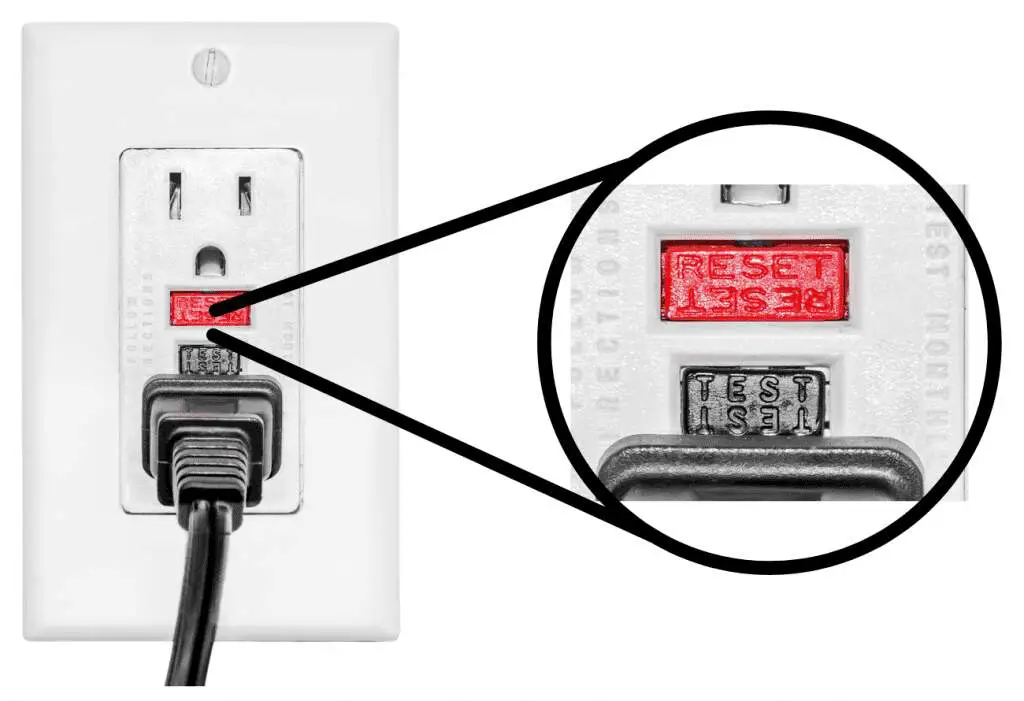
It’s easy to recognize a GFCI outlet because it should have a ‘test and reset’ button on the face of the outlet. Note that one GFCI outlet can protect all the other outlets on the same circuit.
You can test an unmarked outlet by plugging something in, then pressing ‘test’ on the nearby GFCI outlets. If the outlet you’re testing trips after you press test – that means it’s protected by that outlet.
If you don’t think your outlets are GFCI protected, or you’re not sure, you can get a GFCI adapter to plug into an existing non-GFCI outlet (no installation required).
Outside of North America GFCI outlets may be known as RCD outlets.
Step 2: Route the cord so it’s not resting on the floor
You don’t want the extension cord trailing over the floor of your bathroom for several reasons.
- It increases the risk of an electric shock.
- It creates a trip hazard.
- It doesn’t look good.
If there’s ever a leak, or you spill something on the floor, an ill-placed extension cord could get wet and you want to avoid this at all costs.
You need to be especially wary of the part where the bidet connects to the extension cord.
This connection is the weakest link, and the part that’s most likely to cause a problem.
You want the connection to be above the waterline, so it won’t be affected by leaks. I would also suggest keeping it well away from any sinks where it may get splashed.
The second reason is that you don’t want to cause a trip hazard.
Imagine this.
Every time you get up from the toilet, you lightly knock the extension lead. You curse in your head and promise yourself you’ll move it later. (you don’t). Rinse and repeat.
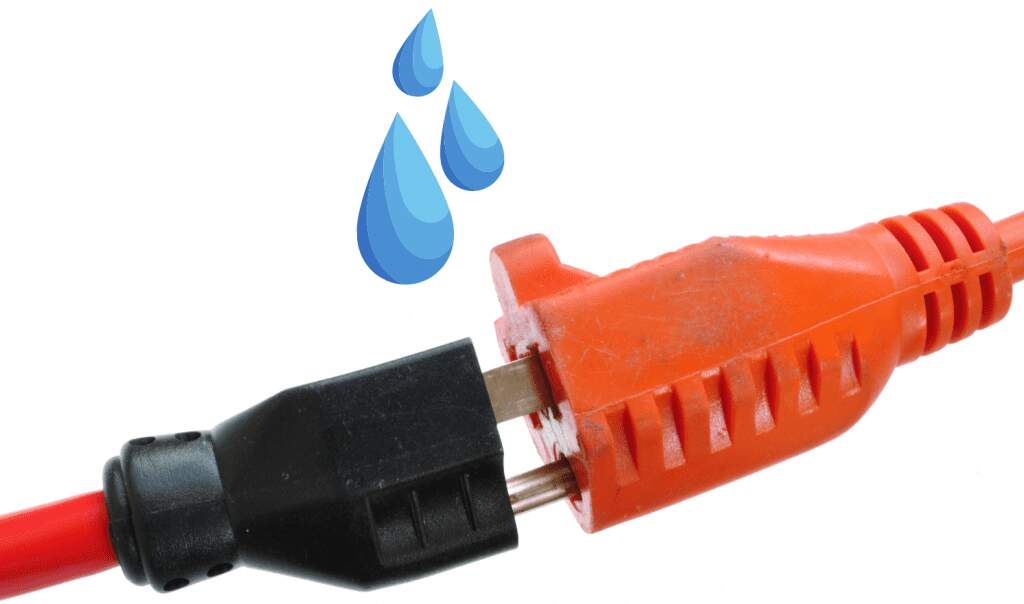
Eventually, the connections will loosen, leaving metal exposed. And exposed metal is a potential shock risk.
Keep the extension lead off the floor and there’s no risk of the connection becoming loose (unless you get a lead that’s slightly too short).
The third reason is simple aesthetics. It doesn’t look good to have an extension cord trailing around your bathroom.
To help you route the cord safely (and in a way that looks good) I recommend you use cord concealers or cord clips.
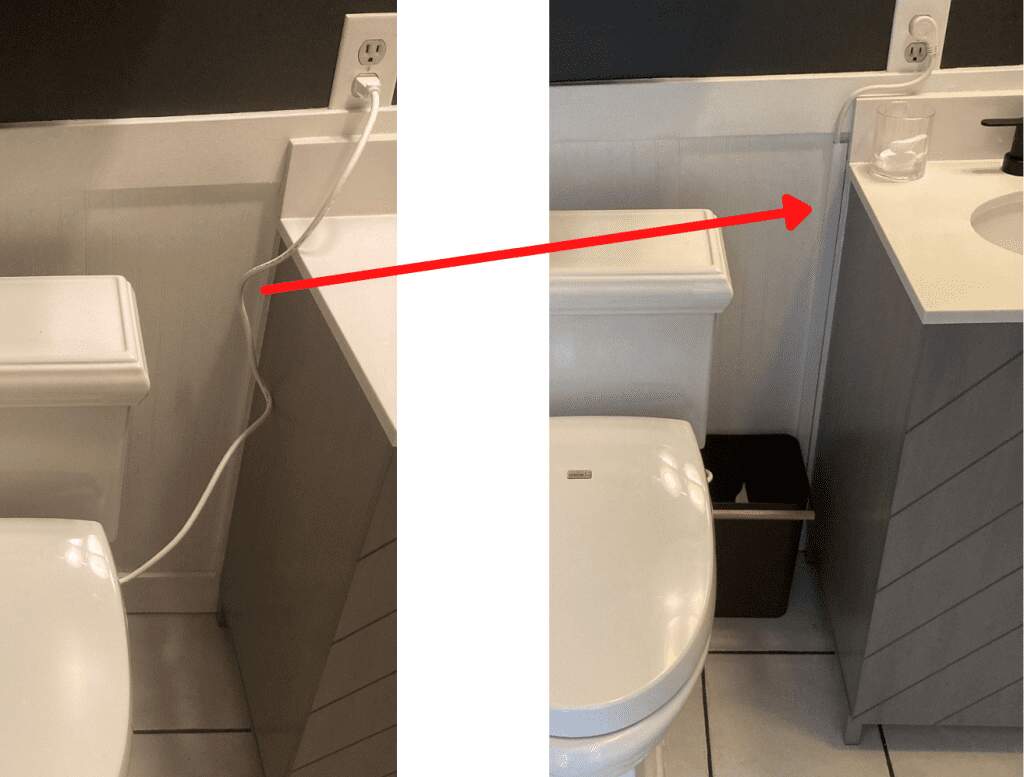
These allow you easily run the extension cord along your chosen path. Cord concealers also provide an extra layer of water protection for the cord.
Make sure you check the clips or covering are big enough to fit your extension cord.
These clips from Viaky are adjustable (up to 0.4”) and come in black and white. Most 15A extension cords won’t be thicker than 0.4mm, but if yours does, Viaky also does clips that will hold wires up to 0.8”!

Most cord concealers should be able to fit one extension cord. I’ve used this set from Delamu before and was very happy with it. The cable run comes in a few different colors, but you can also paint it so it exactly matches your bathroom walls.
